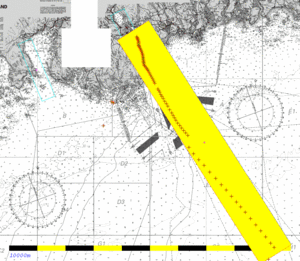
Chart Geotiff
CCGS Matthew - BOT-MVP200 Section
Emerald Basin to Halifax Harbour
11th June 2005
John E. Hughes Clarke
Ocean Mapping Group
University of New Brunswick

Chart Geotiff |
GGE5013 - 2007 - Oceanography Lab CCGS Matthew - BOT-MVP200 Section Emerald Basin to Halifax Harbour 11th June 2005 John E. Hughes Clarke Ocean Mapping Group University of New Brunswick |
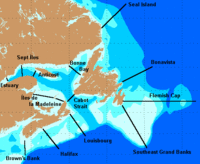 This
is a mid-summer section along the inshore part of an oceanographic
section (the "Halifax Line") that is routinely collected by the Bedford
Institute of Oceanography several times a year. As a subset of this, a
station (#2) in the inshore part is sampled bi-weekly. You can access
the data through the DFO Marine Environmental Data Service, at:
This
is a mid-summer section along the inshore part of an oceanographic
section (the "Halifax Line") that is routinely collected by the Bedford
Institute of Oceanography several times a year. As a subset of this, a
station (#2) in the inshore part is sampled bi-weekly. You can access
the data through the DFO Marine Environmental Data Service, at: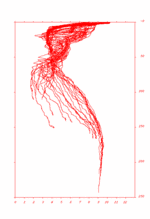 |
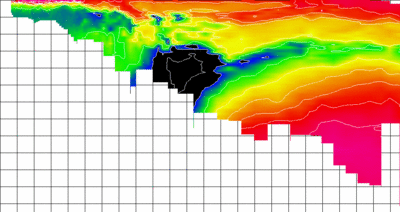 Temperature (grid - 20m vertically, 4000m horizontally , 1 degree contours) -stick plot |
 |
11 deg max 5 deg middle 3 deg min |
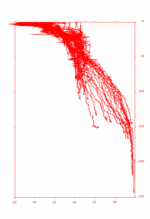 |
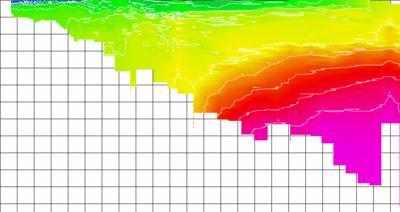 Salinity (grid - 20m vertically, 4000m horizontally , 0.5 ppt contours) - stick plot |
 |
35 ppt max 32.5 ppt middle 29 ppt min |
PC Time: 16:07:48 PC Date: 06-11-2005 GPS Position: $GPGGA,190405.00,4425.3952654,N,06339.7601234,W,2,07,1.7,3.03,M,,,3,0331*23 GPS Time: Bottom Depth: 48.6 Ship Speed: 0.0 ********** Version: 2.21 Line Number: 00000 Instrument Type: 2, AML_CTD_Micro_Sensor Serial Number: 4903 Press Offset: 0.0 AUX. Serial Sensors: 1 Number 5V Inputs: 1 Survey Latitude: 45.000 BOT F1: $GPGGA,190405.00,4425.3952654,N,06339.7601234,W,2,07,1.7,3.03,M,,,3,0331*23 BOT F2: BOT F3: BOT F4: $KMDPT,48.62,0.0,12000.0*4f BOT F5: BOT F6: BOT F7: BOT F8: BOT F9: BOT F10: Ndecimate: 0 ********** P(dbar),C(mmho/cm),T(degC),Dpth(m),SV(m/s),S(PSS-78),Rho(kg/m^3),U1(mV) 1.00, 32.088, 7.589, 0.99, 1475.91, 30.969, 1024.171, 0106.2 0.90, 32.284, 7.583, 0.89, 1476.16, 31.184, 1024.341, 0106.2 0.90, 32.204, 7.659, 0.89, 1476.26, 31.030, 1024.210, 0106.2 0.90, 32.094, 7.797, 0.89, 1476.49, 30.791, 1024.003, 0106.2 0.90, 32.028, 7.857, 0.89, 1476.57, 30.668, 1023.898, 0106.2 0.90, 32.307, 7.827, 0.89, 1476.85, 30.991, 1024.155, 0106.2 1.00, 32.409, 7.800, 0.99, 1476.92, 31.123, 1024.263, 0105.0 |
The files that end in "m1" are
the ones you want. The exapmle to the left shows what the data format
looks like. There are 89 profiles. They are obviously ASCII You can
extract: The time can be seen in Red. (note that the GPS time is in UTC whereas the PC Time (including date in in a sloppy local time) The position can be seen in Blue. The bottom depth can be seen in Brown The profile data can be seen at the bottom. You need to extract the:
|